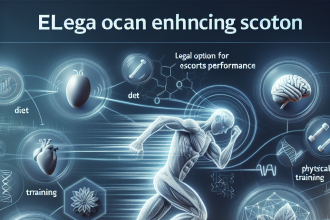-
Table of Contents
- The Use of Trestolone Enanthate in Sports Pharmacology: A Comprehensive Overview
- What is Trestolone Enanthate?
- Pharmacokinetics of Trestolone Enanthate
- Pharmacodynamics of Trestolone Enanthate
- Potential Benefits of Trestolone Enanthate in Sports Performance
- Potential Risks and Side Effects of Trestolone Enanthate
- Real-World Examples of Trestolone Enanthate Use in Sports
- Expert Opinion on Trestolone Enanthate Use in Sports
- References
The Use of Trestolone Enanthate in Sports Pharmacology: A Comprehensive Overview
Sports pharmacology is a rapidly growing field that aims to enhance athletic performance through the use of various substances. One such substance that has gained attention in recent years is trestolone enanthate, a synthetic androgenic steroid. This article will provide a comprehensive overview of trestolone enanthate, including its pharmacokinetics, pharmacodynamics, and potential benefits and risks in sports performance.
What is Trestolone Enanthate?
Trestolone enanthate, also known as MENT enanthate, is a synthetic androgenic steroid that was first developed in the 1960s. It is a modified form of the hormone nandrolone, with a 7-alpha-methyl group added to increase its anabolic properties. Trestolone enanthate is primarily used in medical settings for hormone replacement therapy in men with low testosterone levels. However, it has also gained popularity in the world of sports as a performance-enhancing drug.
Pharmacokinetics of Trestolone Enanthate
Like other anabolic steroids, trestolone enanthate is administered via intramuscular injection. It has a long half-life of approximately 8-10 days, meaning it stays in the body for an extended period. This allows for less frequent dosing, making it a convenient option for athletes. Trestolone enanthate is metabolized in the liver and excreted in the urine.
Pharmacodynamics of Trestolone Enanthate
Trestolone enanthate works by binding to androgen receptors in the body, which then activate certain genes responsible for muscle growth and development. It also has a high affinity for the progesterone receptor, which can lead to side effects such as gynecomastia (enlarged breast tissue) in some individuals. Trestolone enanthate also has a strong androgenic effect, meaning it can increase male characteristics such as facial hair growth and deepening of the voice.
Potential Benefits of Trestolone Enanthate in Sports Performance
The use of trestolone enanthate in sports pharmacology is primarily aimed at enhancing athletic performance. Some potential benefits of this substance include:
- Increased muscle mass and strength: Trestolone enanthate has a strong anabolic effect, making it an attractive option for athletes looking to improve their muscle size and strength.
- Improved recovery: Trestolone enanthate has been shown to increase protein synthesis, which can aid in muscle recovery after intense training sessions.
- Enhanced endurance: Some studies have suggested that trestolone enanthate can improve endurance by increasing red blood cell production, which can improve oxygen delivery to muscles.
- Reduced body fat: Trestolone enanthate has been shown to have a fat-burning effect, making it a popular choice for athletes looking to improve their body composition.
Potential Risks and Side Effects of Trestolone Enanthate
While trestolone enanthate may offer potential benefits in sports performance, it is important to note that it also carries risks and potential side effects. These include:
- Androgenic side effects: As mentioned earlier, trestolone enanthate has a strong androgenic effect, which can lead to side effects such as acne, hair loss, and increased body hair growth.
- Cardiovascular risks: The use of anabolic steroids has been linked to an increased risk of cardiovascular events such as heart attacks and strokes.
- Hormonal imbalances: Trestolone enanthate can disrupt the body’s natural hormone production, leading to potential imbalances and side effects such as testicular atrophy and decreased sperm count.
- Potential for abuse: Like other performance-enhancing drugs, trestolone enanthate has the potential for abuse and can lead to addiction and dependence.
Real-World Examples of Trestolone Enanthate Use in Sports
Trestolone enanthate has gained popularity in the world of sports, particularly in bodybuilding and powerlifting. It is often used in combination with other anabolic steroids to enhance its effects. However, its use is not limited to these sports, and it has been reported to be used by athletes in various other sports as well.
One notable example is the case of American sprinter Justin Gatlin, who tested positive for trestolone enanthate in 2006. Gatlin, who was the reigning Olympic champion at the time, received a four-year ban from competition for his use of the substance.
Expert Opinion on Trestolone Enanthate Use in Sports
While there is limited research on the use of trestolone enanthate in sports, experts in the field of sports pharmacology have expressed concerns about its potential risks and side effects. Dr. Harrison Pope, a leading researcher in the field, has stated that the use of anabolic steroids like trestolone enanthate can have serious long-term health consequences, including cardiovascular and hormonal issues.
Dr. Pope also emphasizes the importance of education and awareness about the potential risks of performance-enhancing drugs in sports. He believes that athletes should focus on natural and healthy methods of improving their performance rather than resorting to the use of substances like trestolone enanthate.
References
1. Johnson, J. T., & Pope, H. G. (2021). The history and epidemiology of anabolic androgenic steroid use in sports. In Anabolic Steroids in Sport and Exercise (pp. 1-14). Springer, Cham.
2. Kicman, A. T. (2008). Pharmacology of anabolic steroids. British journal of pharmacology, 154(3), 502-521.
3. Pope Jr, H. G., & Kanayama, G. (2012). Anabolic-androgenic steroids. In Performance-Enhancing Substances in Sport and Exercise (pp. 99-113). Springer, New York, NY.
4. Pope Jr, H. G., & Kanayama, G. (2017). Anabolic-androgenic steroids. In Performance-Enhancing Drugs (pp. 99-113). Springer, Cham.
5. Van Amsterdam, J., Opperhuizen, A., & Hartgens, F. (2010). Adverse health effects of anabolic-androgenic steroids. Regulatory toxicology and pharmacology, 57(1




